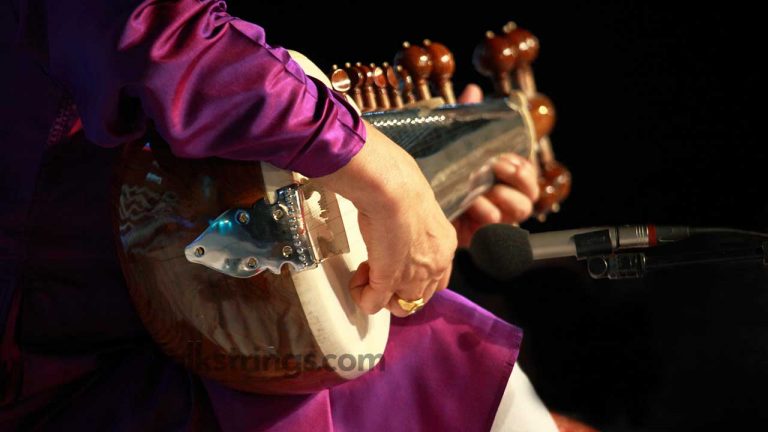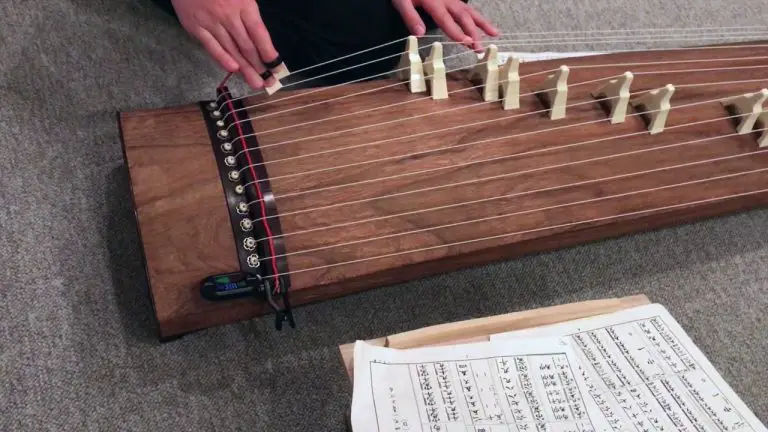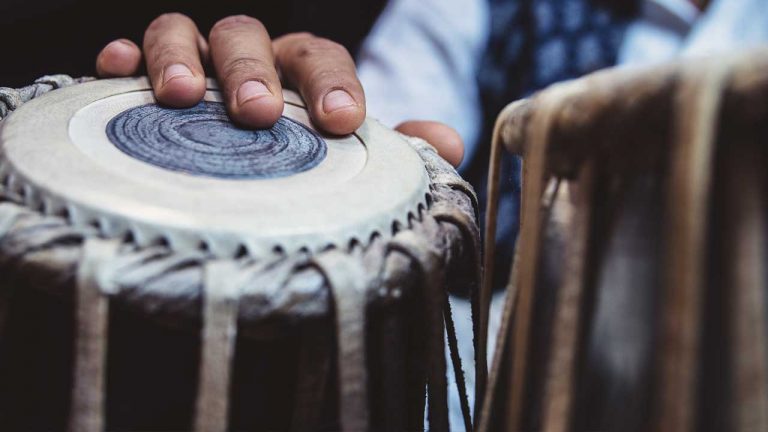What Is the Koto Instrument?
Folkstrings.com is reader-supported. When you buy through links on our site, we may earn a small commission.
Have you ever wondered, what is the Koto Instrument?
The koto is a sizeable instrument that features thirteen strings. This instrument is approximately 160 centimeters long and about twenty centimeters wide.
The koto can even be as long as 200 centimeters. This instrument’s face is curved and musicians adjust the pitch by moving the bridges that are placed under the strings.
To play this beautiful instrument, musicians wear finger picks and pluck the strings. The finger picks for the koto are very similar to the guitar, but they are worn differently.
Musicians use their left hand to suppress the strings and create beautiful music.
Those who are interested in this unique instrument should continue reading, to learn all there is to know about playing the koto.
Table of Contents
- Is the Koto Chinese, Japanese, or Korean?
- How Do I Learn to Play the Japanese Koto?
- Is the Koto Hard to Learn?
- How to Tune a Koto Instrument
- How Much Does a Koto Instrument Cost? Why Are They So Expensive?
- Where Can I Buy a Koto Instrument?
- How Do You Buy a New or Used Koto Instrument?
- What Is The Koto Instrument – Conclusion
Is the Koto Chinese, Japanese, or Korean?
The koto is a Japanese instrument, though it has roots in Chinese and Korean cultures. The koto we know and love today is derived from the Chinese zheng and the se. It also is believed to come from the Korean gayageum and the ajaeng.
This instrument is made from the beautiful Paulownia tree wood, which is native to Japan. This tree is also known as the Empress tree, and the wood from these trees is referred to as Kiri.
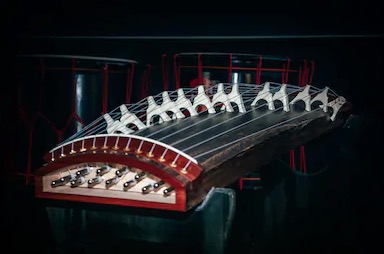
The closest ancestor to the koto is the Chinese guzheng, and it was introduced to Japan between the 7th and 8th centuries. The Japanese koto belongs to a musical instrument family called the zither.
The instrument gets its name because koto was a general term for all stringed instruments around the time the guzheng first arrived in Japan. The koto was used to create romantic music and was a popular instrument among the wealthy class of Japan.
One of the biggest influencers of koto music was a musician by the name of Yatsuhashi Kengyo. He changed the way the koto was played, creating new music that helped this instrument to continue to evolve.
In 2002, a female musician named Keiko Nosaka felt too confined by the traditional 13-string koto, so she created different versions, some having 20 strings or even more.
The koto is an exquisite instrument when it is adorned. Artisans use ivory, tortoise shells, ebony, and metal, to create stunning instruments.
It is important to note that the koto is considered the national instrument of Japan and is still enjoyed today. This instrument has become a symbol of Japanese culture and is highly prized for its beauty and melodic music.
How Do I Learn to Play the Japanese Koto?
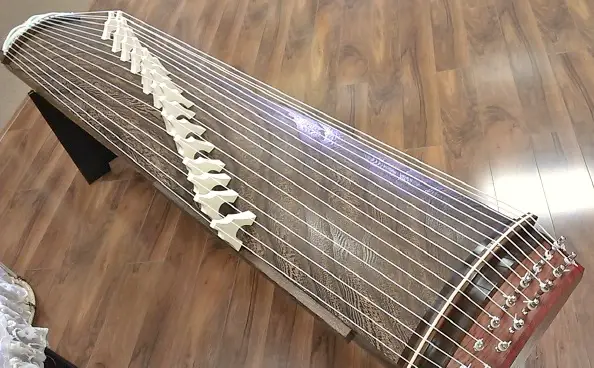
Instruments like the koto are gaining interest all over the world. People want to learn this instrument that is steeped in Japanese tradition. Learning this instrument requires a concerted effort and time.
Proper Position
Before learning to play the koto, you must understand the proper position. The koto is traditionally played while sitting on the floor because of its expansive size. You will need to sit down and open your knees to the width of your waist.
This is called seiza-style. Make sure your hips and spine remain straight and your upper body is relaxed. There should be a couple of fists lengths between your knees.
The position of the musician is just as important for playing style as it is for tradition. You will use your right hand and three finger picks to pluck the koto. Your left hand will bend the strings. When playing the string farthest from you, never bow. Simply bend at the waist without twisting.
If you are looking at printed music, it would be wise to use a music stand. This stand will elevate the music and allow you to see the printed music over the koto.
Koto Picks
You will wear the koto picks on your thumb, index, and middle finger. Keep your fingers curved gently and pluck the strings with the edges of the finger picks. The tone you create will depend on the thickness of your koto picks. In the beginning, you will mostly pluck the strings with your thumb. As you gain confidence, you can add in your index and middle fingers.
Left Hand
The art of pressing the strings and manipulating the bridges with your left hand is called oshide. Tensing the string with your left hand allows you to change the tune or sound. It is important to note, in the beginning, your fingers are going to get sore easily. Once your fingers toughen, the pain will subside.
Practice makes perfect. You need to get a feel for the koto first and then work towards playing music. The following videos should help to get you started on learning how to play the koto.
Is the Koto Hard to Learn?
The koto is not overly difficult, though it does present a challenge. Those who have played other stringed instruments may find it hard to grow accustomed to the change in picking and pressing the strings.
The koto must first be tuned, but it is not tuned like other stringed instruments. Koto players tune their instruments according to the songs they are playing.
One of the biggest issues with learning to play the koto is finding resources in English. If you know Japanese, you should have no problem reading music or learning the playing style.
If you can find a koto master teacher, you will learn the traditional methods of playing the koto. Most people cannot learn to play this large instrument without some type of lessons.
How to Tune a Koto Instrument
Tuning a koto is like no other stringed instrument. All the strings on the koto are stretched to the same tension level.
This instrument is tuned using the bridges, which are put in place just before playing. The bridges can slide up and down the strings, to create different tones.
If you slide the bridges towards the tail of the koto, the strings become tighter and the playing area is lengthened, producing a deeper sound. When the bridges are slid towards the head, the playing area is shortened and the tone is raised.
As stated above, you tune your koto according to the song being played. Each piece of koto music states the proper tuning scheme. The strings are numbered and tuned according to the song.
Although each song is marked with the correct tuning scheme, this is only the beginning. While playing the koto, musicians must continuously adjust the bridges lower or higher, to create distinct tones throughout a piece.
This video should help you get started on learning how to tune your instrument.
How Much Does a Koto Instrument Cost? Why Are They So Expensive?
A traditional full-sized koto instrument will vary in cost but typically hovers around $1000. A travel-size compact version will cost around $200-$300.
Just like with any instrument, you could undoubtedly go and purchase a cheap koto, but it will not sound like a traditional Japanese koto, and it certainly will not last long.
A lot of artistic skill goes into the making of beautiful instruments like the koto. Making one of these instruments by hand takes hours of labor. The design and inlay materials can also cause the price to rise.
It is possible to purchase a koto and have it shipped from Japan. Other countries make koto instruments, but they are not always made with traditional Kiri wood and may be made from subpar materials, making them more suitable for display rather than playing.
When purchasing a Japanese koto, you must conduct careful research. Know what to look for in an instrument. Purchase from a reputable dealer that sells traditional Japanese koto instruments.
If you perform research and do not rush the purchase process, you will feel more confident purchasing a Japanese koto to add to your collection and begin learning to play.
Where Can I Buy a Koto Instrument?
The best place to buy any instrument is at a location where the sellers really know the instrument so that you can ask any questions and get some good recommendations. The problem with the koto instrument is that it’s such a rare and niche item, it can be tricky to find a good retailer.
How Do You Buy a New or Used Koto Instrument?
If you’re based in America or the UK, buying a secondhand koto instrument might be the more realistic option mainly due to the rarity and there not being many retailers.
Kotos are not very widely available or easy to pick up.
A quick search on Google in 2022 took me to a small shop in California called ‘Sound of Asia‘. The site looks quite dated.
The only other viable option for me would be to check out a . The m main benefit of buying a secondhand instrument is that you may get some extra items thrown in such as tuning and cleaning tools or books to help you learn the koto that the previous user obviously wouldn’t need anymore.
Some sellers of new products are based in Japan, as many are manufactured there, so might actually be your best bet for an authentic Koto instrument. But do be aware that shipping will of course take a longer time if it’s coming straight from Japan.
What Is The Koto Instrument – Conclusion
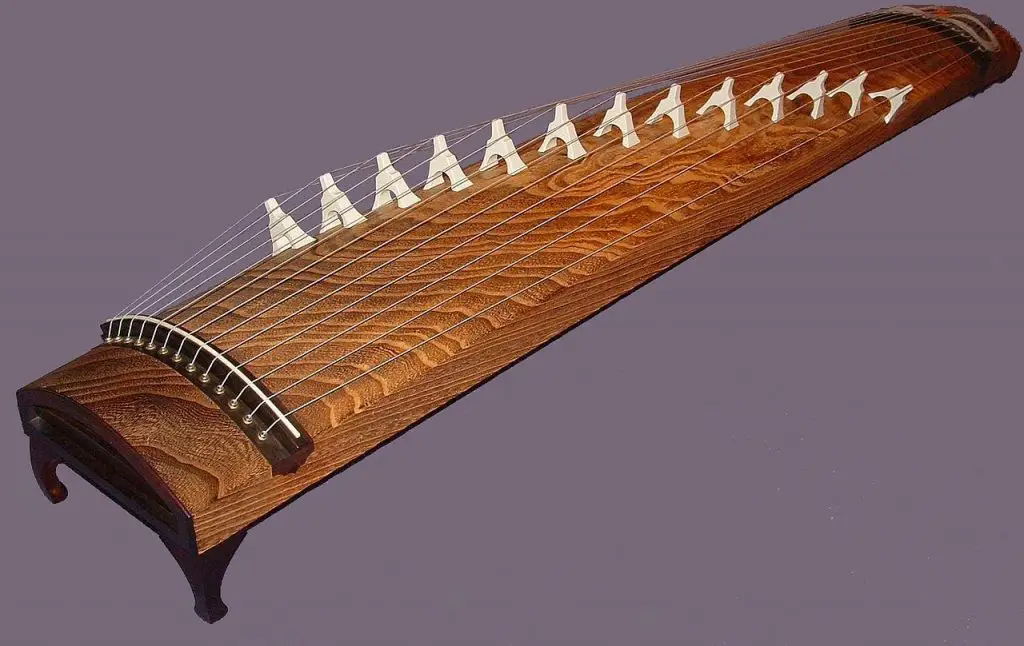
The koto instrument is one of genuine beauty and an amazing tune. If you love traditional Japanese music, learning the koto will bring it home to you.
This is not an instrument you can sit down and learn to play within a few sessions. Although it is not overly difficult to play the koto, it requires quite a learning curve.
Even if you are a guitar player or other stringed instrument musician, you may find it difficult to transition from your current stringed instrument to the koto.
Once you learn to play this amazing instrument, it will take you back in time to Japanese culture. The koto undoubtedly creates the most amazing tones you will ever hear from any instrument.
Author Profile
-
Daniel Johnstone is an English writer with a love for stringed instruments from around the world.
He shares his love for these instruments through his writing for folkstrings.com, a website dedicated to all things related to folk string music.
Daniel's passion for music started at a young age, and he has since become an accomplished musician, playing guitar, cavaco, and recently, the harp.
His dedication to learning and sharing his knowledge of stringed instruments is evident in his insightful and engaging blog posts. Whether you're a seasoned musician or a beginner, Daniel's writing is sure to inspire and entertain you.
When he's not playing music or writing, you can find Daniel exploring new instruments and seeking out new sounds to share with his readers.
Latest entries
 AutoharpApril 4, 2024What Is the Autoharp Made Of: Exploring Its Materials and Craftsmanship
AutoharpApril 4, 2024What Is the Autoharp Made Of: Exploring Its Materials and Craftsmanship AutoharpApril 4, 2024Is Autoharp Easy to Play? Unveiling the Truth for Beginners
AutoharpApril 4, 2024Is Autoharp Easy to Play? Unveiling the Truth for Beginners AutoharpApril 4, 2024What Is an Autoharp Worth? Your Guide to Pricing and Value
AutoharpApril 4, 2024What Is an Autoharp Worth? Your Guide to Pricing and Value AutoharpApril 4, 2024Are Autoharp and Zither the Same Thing? Unraveling String Instrument Myths
AutoharpApril 4, 2024Are Autoharp and Zither the Same Thing? Unraveling String Instrument Myths
Affiliates:
This post may contain affiliate links that at no additional cost to you, the site may earn a small commission. We only recommend products we would use ourselves and all opinions expressed on this site are our own.
Accuracy Advice:
While we strive to provide up-to-date and accurate information, the content in this article may not reflect the most current research or medical guidelines. We encourage readers to do further research and consult with professionals for more personalized advice.
Our Recommendations:
The products and services mentioned in any of our articles are recommended based on our independent research and personal experience. We are not sponsored by any company. We aim to suggest products and services we believe are of high quality and could be beneficial to our readers.

